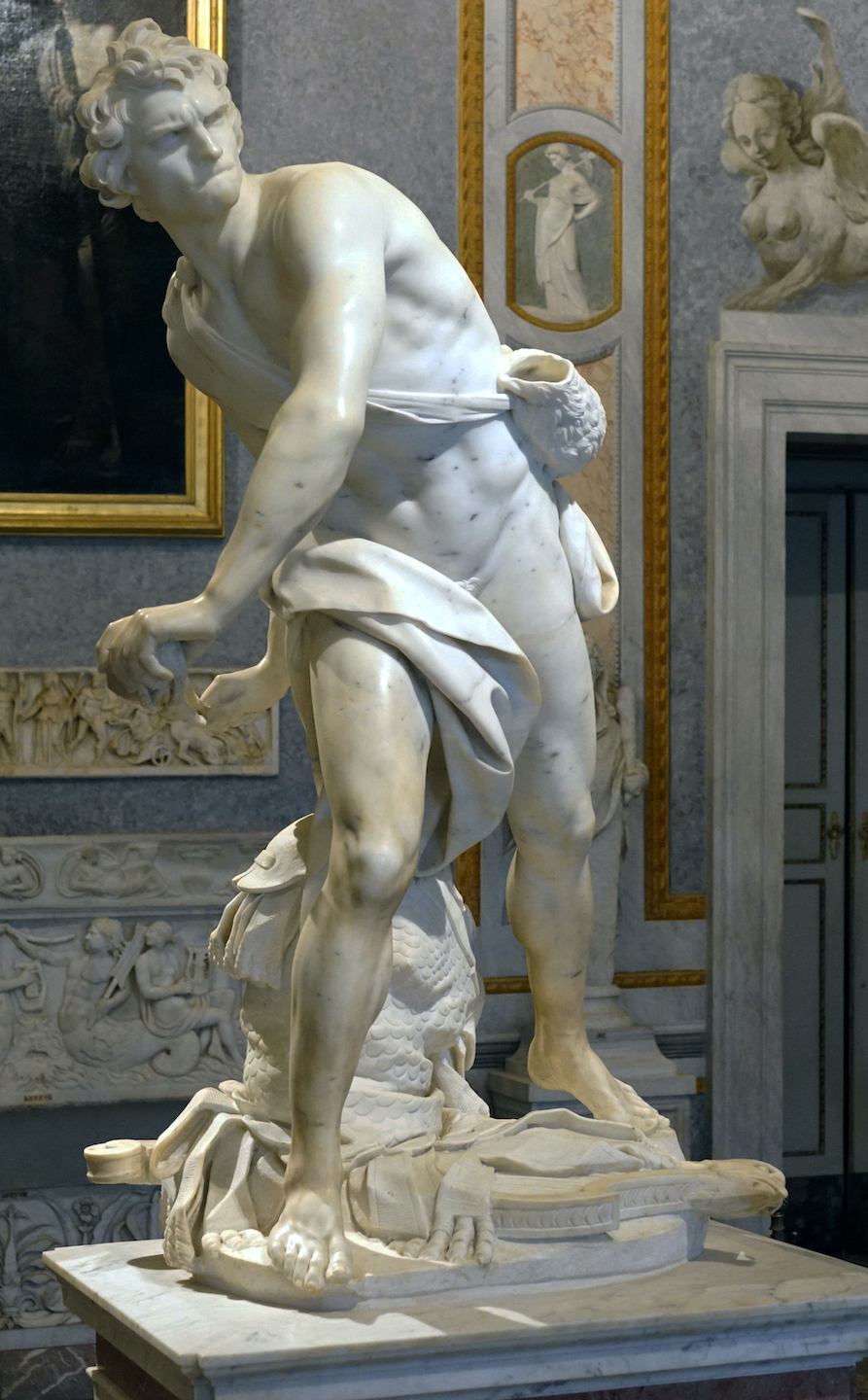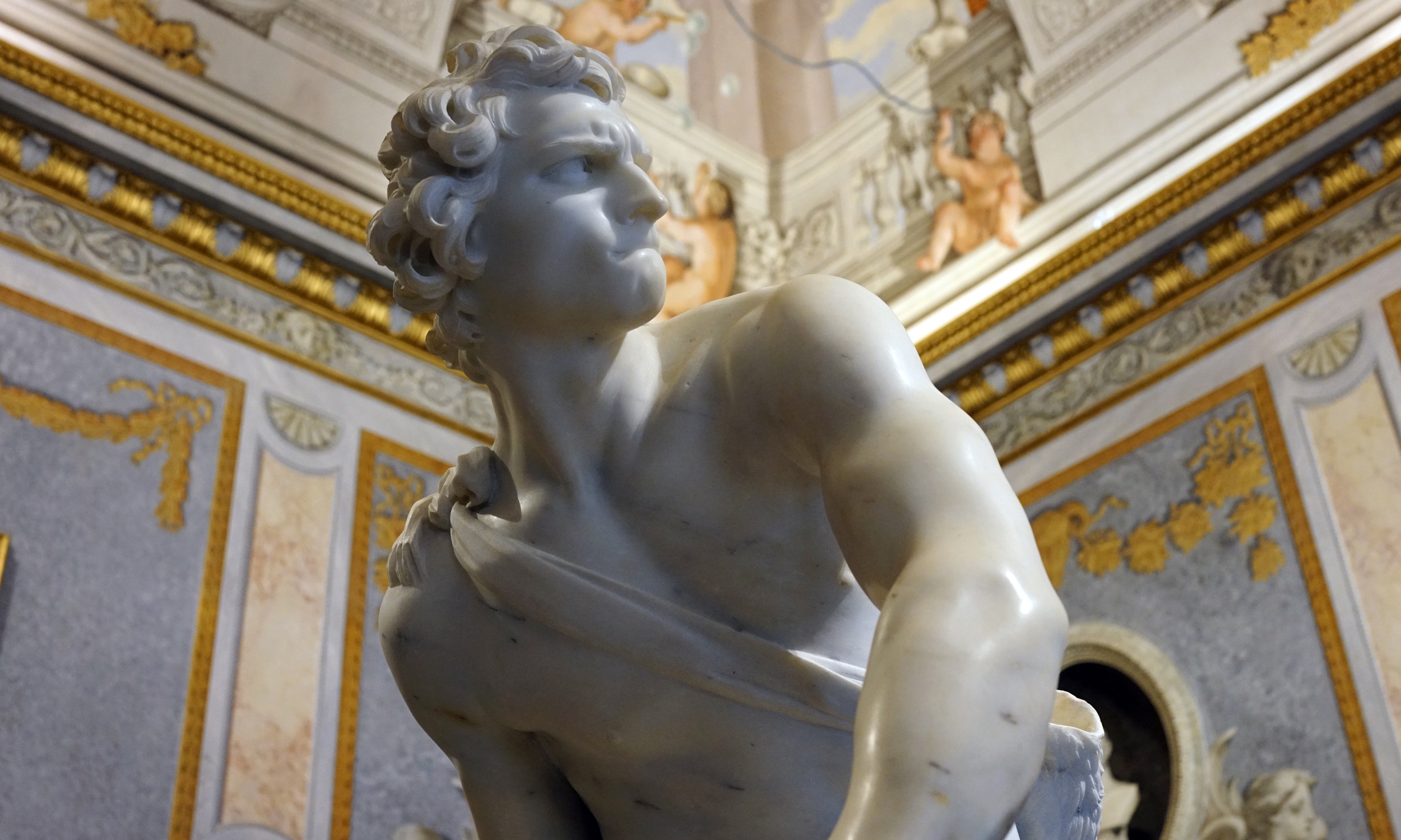Gian Lorenzo Bernini, David, 1623, marble, 170 cm high (Galleria Borghese, Rome)

Gian Lorenzo Bernini, David, 1623–24, marble, 170 cm high (Galleria Borghese, Rome; photo: Steven Zucker, CC BY-NC-SA 2.0)
Empathy
Bernini’s David is like a major league pitcher winding up to throw a 95-miles-an-hour fastball. The pitcher gathers all of his strength for each pitch and puts everything he has into it.
Baroque art wants us to be able to relate to the image in our bodies, not just in our minds. Bernini’s David uses the space around it—reaching out into the space of the viewer. Bernini’s David is not content—the way Michelangelo’s David is—to remain separate from us. When looking at Bernini’s David, we immediately start to feel what David is feeling. This empathy is important to Baroque art.
Diagonals
In the High Renaissance we saw the composition in the form of a pyramid—a stable shape. But in the Baroque era we see compositions in the shape of diagonal lines, as in Bernini’s David. The diagonal line immediately suggests movement and energy and drama—different from the immobility of the pyramid shape.

Left: Donatello, David, c. 1440s, bronze, 158 cm (Bargello, Florence; photo: Steven Zucker, CC BY-NC-SA 2.0); right: Michelangelo, David, 1501–04, marble, 518 cm (Galleria dell’Accademia, Florence; photo: Steven Zucker, CC BY-NC-SA 2.0)
Three Davids
Donatello shows us an early moment in the Renaissance—the beginnings of humanism when artists were first discovering contrapposto and the beauty of ancient Greek and Roman sculpture. His young figure of David symbolizes the Republic of Florence, which saw itself—like David—as blessed by God. Donatello shows David victorious standing on the head of Goliath.
Michelangelo’s David is ideally beautiful. David contemplates his upcoming fight with Goliath, staring at his foe. While Bernini shows us a less ideal, and more real David—one who, with God’s help, is actively fighting Goliath (perhaps the way the Church itself felt as they were battling against Martin Luther).

Gian Lorenzo Bernini, David (detail), 1623–24, marble, 170 cm high (Galleria Borghese, Rome; photo: Steven Zucker, CC BY-NC-SA 2.0)
The path to God
Michelangelo seems to be asking us to contemplate the incredible beauty of David, and through contemplating beauty (the beauty of man, God’s greatest creation), we come to know God. On the other hand, there is no time for contemplation with Bernini’s David, there is only time for ducking out of the way—our reaction is in our bodies, not in our minds.
The path to God in the Baroque era is more direct, more emotional, more bodily, and that of course relates to the embattled position of the Church, which wanted to appeal directly to the faithful.
Additional resources
This sculpture at the Galleria Borghese
Bernini at The Metropolitan Museum of Art’s Timeline of Art History
Read a Reframing Art History chapter about the sacred baroque in the Catholic world
Smarthistory images for teaching and learning
[flickr_tags user_id=”82032880@N00″ tags=”BerniniDavid”]
[0:00] [music]
Dr. Beth Harris: [0:04] We’re in the Galleria Borghese here in Rome, looking at one of several sculptures that Bernini, as a young man in his 20s, made for Cardinal Borghese here in this fabulously beautiful villa. This is the sculpture of David.
Dr. Steven Zucker: [0:19] The story comes from the Old Testament, and the young man who will become King David.
Dr. Harris: [0:24] He’s a shepherd, and the Israelites are in battle with the Philistines.
Dr. Zucker: [0:29] A giant of a man, Goliath, is so powerful that nobody wants to meet him directly, but David takes off his armor and goes to meet him, not even armed with a sword.
Dr. Harris: [0:38] He gathers some stones and he goes to face Goliath, and it is God on the side of the Israelites. David has that behind him when he goes to face and defeat Goliath, which he does with one stone from the slingshot.
Dr. Zucker: [0:53] Which hits Goliath between the eyes and fells him. David then takes the giant’s sword and severs his head. This is the moment of action itself.
[1:00] When most people think of a sculpture of David, they think of Michelangelo’s High Renaissance sculpture.
Dr. Harris: [1:05] And that dates to the early 1500[s]. Here we are, more than 100 years later, and we’ve moved from the High Renaissance into the period of the Baroque.
Dr. Zucker: [1:14] Bernini knew all about Michelangelo’s triumphant sculpture, “David,” and it informs this, but Bernini is making this sculpture his own.
Dr. Harris: [1:21] Well, we’re in a very different moment in history. Michelangelo’s sculpture during the High Renaissance was looking back to ancient Greek and Roman art, this interest in classical antiquity, this moment of humanism, in the Renaissance, of idealizing the human body.
Dr. Zucker: [1:37] Creating a stable columnar figure, making the human body seem almost like a classical column in its purity, in its elegance.
Dr. Harris: [1:45] Michelangelo’s David has tension in the muscles and a lot of tension in the face, and a sense of drama in the face as he stares down Goliath, but it’s as though that drama that was just incipient in Michelangelo is really here unleashed by Bernini.
Dr. Zucker: [2:01] He’s like a spring that’s about to unwind.
Dr. Harris: [2:03] Michelangelo gives us the moment before the fight with Goliath, and Bernini is giving us the moment where David is about to release this slingshot and kill this giant of a man, Goliath.
Dr. Zucker: [2:15] In fact, some people have said that they don’t want to stand in front of the sculpture because it looks like that slingshot might hit them. Bernini is able to activate the space around the stone.
Dr. Harris: [2:25] That’s one of the big differences between the High Renaissance and the Baroque. With Michelangelo’s David, we are very separate. We contemplate his ideal beauty, but here we’re emotionally, bodily involved.
Dr. Zucker: [2:36] Look at the torsion in David’s body, the way he’s twisted and is about to spin that rock and unleash it.
Dr. Harris: [2:42] The body crosses itself, which is not something we see in Michelangelo’s David. The body forms this diagonal line that has so much energy.
Dr. Zucker: [2:51] Look at the knit brow of his focused attention. Look at the way that the lips are pressed together, making so clear his intense concentration.
Dr. Harris: [3:00] You can feel that he’s gathering every ounce of strength that he has to throw this stone. He’s got God behind him, but he’s still using all of his strength. I always find myself wanting to say, “You can feel it,” when I describe Baroque art. I think that’s the whole idea of Baroque art.
Dr. Zucker: [3:20] It is a direct confrontation with the narrative. It is meant to bring us into the story, and Bernini does this so well that we forget that this is stone.
Dr. Harris: [3:29] That emotional involvement, that almost bodily involvement where we almost want to duck out of the way, is so typical of Baroque art. This moment in the 1600s when the Catholic Church is using art as a way to affirm and strengthen the faith of believers.
Dr. Zucker: [3:47] That was a major tenet of the Counter-Reformation, of the Council of Trent, that suggested that art was didactic, that art could be a teaching tool to help deepen one’s faith.
Dr. Harris: [3:56] “Teaching” is a funny word because it sounds so distant, but the art of the Baroque, it doesn’t feel like a lecture. It feels like we’re being brought in. It feels seductive.
Dr. Zucker: [4:05] Look at the naturalism here. Look at his understanding of the human body, of its musculature, of the skeletal structure, even in this enormously complex pose. This is an artist who has taken all of the lessons of the High Renaissance, but activated them and turned them to a purpose that even Michelangelo, I think, could not have predicted.
Dr. Harris: [4:22] When I look at Michelangelo’s David, I feel as though I’m looking at a figure that is superhuman, too beautiful to be someone that you would pass on the street, but Bernini’s David looks like a man. He is depicted naturalistically, but he’s not idealized like a god. That is such a High Renaissance characteristic.
[4:39] The naturalism that you’re talking about we see in Caravaggio, we see here in Bernini, it’s very much a characteristic of the Baroque.
Dr. Zucker: [4:47] These are artists that bring the Bible into our world.
[4:49] [music]

